Manitou
Preparazione del gioco
Digitando il commando /join nella chat è possibile aggiungere da 2 a 4 giocatori. Digitando invece /start si da inizio alla partita. Alternatively, you can also use the Strumento di Gioco.
The gioco
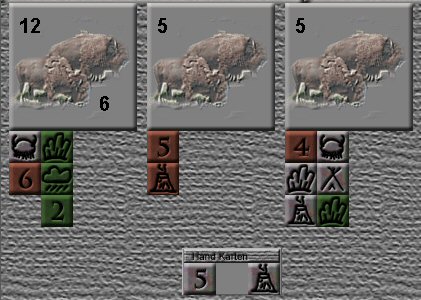
< span>The chief puts together a hunting party from his warriors and hunters to kill buffalo and capture opposing Indians. Whoever has killed the most buffalo and caught the most opponents after three hunting seasons (rounds) wins the game. But be careful - fur robbers often thwart the chief's plans.
Svolgimento
Assemble a hunting party
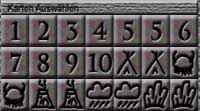
Each player has 11 hunters (numbers) and 10 warriors (figures) to choose from. Hunters appear once each with the values 1-10 (exception: the five is double), the warriors appear twice each.

Chief

Medicine Man

Rainmaker

Scout

Squaw

Each player selects eight cards at the beginning of each round and confirms the selection with OK. The player sitting in front of the starting player is only allowed to choose seven cards in order to somewhat compensate for the advantage of being the last to place. If you make a mistake, you can remove a card from the selection at any time by clicking on it before confirming.

Have all players have chosen, the game begins and each player has three of their eight pre-selected cards (drawn at random) in their hand. To create it, drag and drop the desired card to the desired buffalo herd.
Caution: once you have clicked on the card, it will automatically be placed on the herd when you let go, where the mouse pointer is currently located. If you click, you can simply drag the card (if you haven't released it yet!) to the field on the right with the table and let it go there. Then the card jumps back into the hand and you can take another one.
The card hand is automatically filled up to three cards again.
Buffalo cards
There are three types of buffalo herds:
{ 10}Small buffalo herds with a value of 1 to 7 (x)
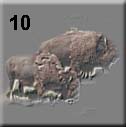
Medium Buffalo herds with a value of 9 to 13 (X)
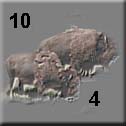
Large buffalo herds exist from a medium and a small herd of buffalo (X x)
Depending on the number of players, the distribute the buffalo cards to three buffalo places as follows:
| Numero di giocatori | 1. Herd | 2. Herd | 3. Herd |
|---|---|---|---|
| 2 | X x | x | x |
| 3 | X x | X | x |
| 4 | X x | X x< /td> | x |
Cacciatore (Hunter)
< p> Using your hunter cards you can hunt the three herds of buffalo, which display different point values. To do this, you place one hunter (number card) per round on the herd you want to hunt. The person who has the largest number of number cards in a buffalo herd gets the points shown on the buffalo card. With the large buffalo cards, not only the player with the most point cards gets the points, but also the player who sent the second most hunters on the hunt. This person then receives the smaller point value. Third and fourth come away empty-handed. If only one player has created hunters, he receives both point values alone. If there is a tie, everyone gets nothing!Warriors
A second one Way to score points is to take prisoners with the warriors. To do this - just like with hunters - you place a warrior on one of the buffalo herds.
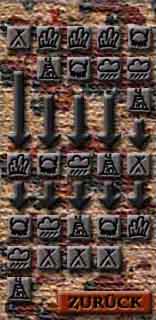
The table to the right of the playing field shows which warrior is inferior or superior to which .
The middle row shows the starting position: all warriors who are above another are superior to that one, all warriors who are Those who are below another are inferior to the other and are beaten by the superior.
Example: In the first column, the chief is the starting position. Above him is the squaw, which can beat the chief. Below the chief are the medicine man, the rainmaker and the scout. These three are defeated by the chief.
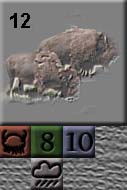
Only one player's warrior in a herd can be the winner . This is shown in the player's color, like the medicine man (red helmet) in this example.
If another player places his warrior that is above the one already in the table, the color of the inferior one changes to gray and the superior one is active (colored) . In this example, the cloud (rainmaker from green) was played first and then defeated by placing the red medicine man.
A player places the same warrior as the currently active warrior, both are neutralized and turn gray. Neither of them is now active and you can now place any warrior who is then considered active.
Whoever has the last active (colored) at the end of the round Heroes who are adjacent to a herd receive all enemy hunters and defeated warriors adjacent to this herd as prisoners. Each prisoner counts one point. You get your own hunters and defeated warriors back and can send them hunting again in the next round. However, the prisoners are lost to the other players for the rest of the game.
The medicine man in this example would take 3 prisoners (green 8, green rainmaker, blue 10 ), so 3 points would be for red. These bonus points are displayed in small size at the bottom of the respective herd at the end of the round.
Protect warriors
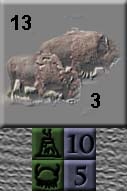
To protect your own active warrior, you can add a second warrior. However, more than two active warriors of a player may not be placed in a herd. The first active warrior placed is now protected by the second active warrior. The other players must first eliminate the last warrior placed by a “sacrifice” before they can attack the warrior placed first. Sacrificing means that the attacking warrior also "dies". Both the attacker and the protecting warrior become inactive and turn gray. Only the next attacker can now defeat the top active warrior.
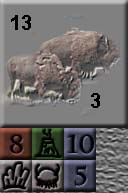
In this example, the green scout is attacked first green medicine man protected. Red now sacrifices his chief: the red chief defeats the green medicine man, but breathes his own life in the process and both turn gray. Now red or blue can try to defeat the scout.
Round accounting
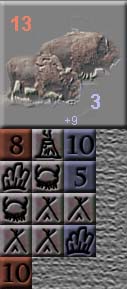 < p> A round ends when each player has placed seven of their eight cards. A card always remains in the hand and is not played. It will be available for selection again in the next round.
< p> A round ends when each player has placed seven of their eight cards. A card always remains in the hand and is not played. It will be available for selection again in the next round. Now all three buffalo herds are accounted for:
- < li>The player with the most hunters (sum of the number cards) receives the highest number of points in the herd (here 13 points for red). If it is a large herd (with two numbers), the person with the second most hunters receives the smaller number (here three points for blue).
- The player who ends up with the last active warrior in the herd , receives all opposing cards as prisoners: one point per prisoner (nine points for blue).
These points are shown in the corresponding player color on the buffalo card.
After the settlement, each player must click somewhere on the playing field once to confirm in order to start the next hunting season.
The fur robber
The Indian tribe that used the most hunters on all herds combined in a round (sum of the numbers , not the number of hunters), of course attracts fur predators through its prey. They steal ten buffalo skins from him, which earns him -10 points.
Fine del gioco
The game ends after three hunting seasons (Round). The player with the highest score wins.

